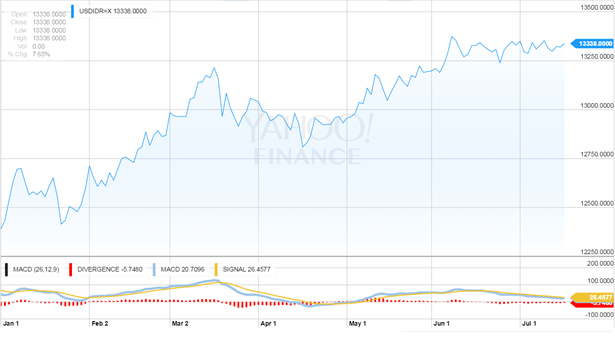Indonesian Rupiah Headed for more Declines against US Dollar
For most of this year, the Indonesian rupiah has met selling pressure against the US Dollar. Year-to-date price activity in the USD/IDR shows a rise from below IDR 12,250 to new highs above IDR 13,330 per US dollar. For Indonesian export companies, this is great news as it means that their products will be cheaper for foreign consumers to buy. For the domestic economy, this creates a different set of implications as it also makes it less likely that foreign investors will be looking to buy into Indonesian assets.
As long as these trends continue we will more than likely see continued downside in the Indonesian rupiah. Recent Commitment of Traders (COT) reports from Juno Markets have shown that sentiment toward the US dollar remains bullish, and this is likely coming as a result of the increased likelihood that the Federal Reserve will increase interest rates before the end of this year. Since this is something that is now expected at most of the world’s central banks, there is little in the fundamental analysis picture that points to major selling in the USD over the next several months. This ultimately means that Southeast Asian investors should expect continued upside in the USD/IDR.
For assets that are denominated in rupiah, this is a somewhat troublesome scenario (at least from a short-term perspective). But this does not mean that all Indonesian stocks are likely to post declines for the period -- it simply means that investors will need to be more selective in their positioning and exposure to Southeast Asian markets. Indonesian stocks that are most likely to benefit from the current environment will be stocks that have the broadest global reach and the ability to attract foreign consumers. Some of the best companies that fall into this category tend to work in the commodities space, so this is clearly an area that should be monitored by investors that are still looking to get into regional stocks from the long side.
USD/IDR Chart:

Going forward, currency valuations will be a key indicator of whether or not the Indonesian rupiah is likely to find a sufficient number of buyers to generate bullish momentum in prices. As a general rule, it should be understood that falling currency values will be a negative for the Indonesian stock market as a whole. But when we look at specific industry sectors, some stocks will certainly look better than others. Companies that are closely tied to the export of raw materials stand to outperform companies that are more focused on the domestic economy in Indonesia. These are the areas that are likely to gain greater investor attention as we move into the second half of 2015.
